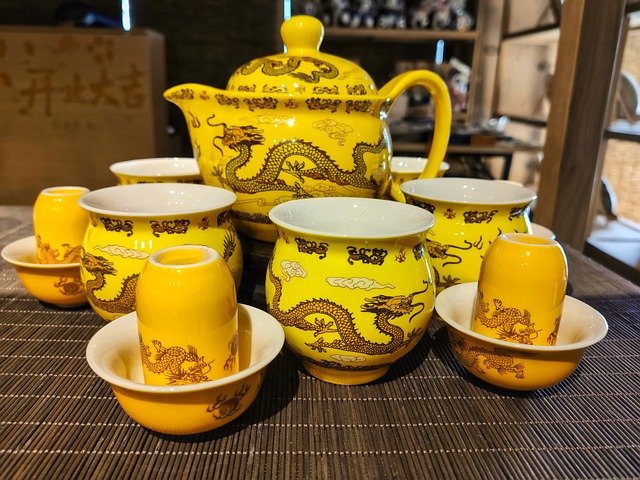Timeless Elegance: The Enduring Appeal of Vintage Tableware
The dining room has long been a showcase for family heirlooms and cherished collectibles, with vintage tableware holding a special place in many homes. From delicate porcelain teacups to sturdy ironstone platters, these pieces carry stories of past generations and add character to modern table settings. The resurgence of interest in vintage tableware reflects a desire for authenticity and craftsmanship in an era of mass production. Collectors and casual enthusiasts alike are drawn to the unique designs, rich history, and superior quality of these enduring items. As we explore the world of vintage tableware, we'll uncover its origins, popular styles, and how to incorporate these timeless pieces into contemporary dining spaces.

The Rise of Collectible Tableware
The concept of collectible tableware emerged in the 18th century with the development of fine porcelain in Europe. Royal patronage and aristocratic tastes drove demand for elaborate dinner services, leading to the creation of iconic brands like Meissen and Sèvres. As manufacturing techniques improved and the middle class grew, more affordable options became available, sparking a wider interest in decorative tableware. The Victorian era saw an explosion of patterns and styles, with many households proudly displaying their best china in specially designed cabinets. This tradition of collecting and displaying fine tableware continued well into the 20th century, setting the stage for today’s vintage market.
Popular Styles and Patterns
Vintage tableware encompasses a wide range of styles, from ornate Rococo designs to sleek Mid-Century Modern pieces. Some of the most sought-after patterns include:
-
Blue Willow: This classic Chinese-inspired design has been in production since the late 18th century and remains popular today.
-
Fiestaware: Introduced in 1936, this colorful American pottery is known for its Art Deco influence and durability.
-
Spode’s Blue Italian: Dating back to 1816, this blue and white transferware pattern features romantic Italian landscapes.
-
Corelle’s Butterfly Gold: A quintessential 1970s design, this pattern adorned countless kitchen tables during its heyday.
-
Franciscan Desert Rose: This California-made dinnerware, with its hand-painted pink roses, was a staple of mid-20th century homes.
Each of these patterns, along with countless others, offers a glimpse into the aesthetic preferences and cultural values of its time.
The Hunt for Vintage Treasures
For many collectors, the thrill of the hunt is a significant part of the appeal of vintage tableware. Antique shops, flea markets, estate sales, and online marketplaces are all potential sources for rare and desirable pieces. Serious collectors often specialize in particular brands, patterns, or eras, developing extensive knowledge of marks, production dates, and variations. However, even casual enthusiasts can enjoy the process of gradually building a unique collection that reflects their personal style and interests.
Incorporating Vintage Tableware into Modern Homes
While some collectors prefer to keep their vintage tableware safely behind glass, many choose to use these pieces in their daily lives. Mixing vintage and contemporary elements can create a rich, layered look that adds personality to any dining space. Here are some ways to incorporate vintage tableware into modern settings:
-
Use vintage plates as a focal point on open shelving or plate racks.
-
Mix and match different patterns for an eclectic table setting.
-
Repurpose unique pieces as decorative objects, such as using a teacup as a planter or a serving bowl as a catchall.
-
Create a cohesive look by choosing vintage pieces in a consistent color palette.
-
Use vintage serveware to add character to a buffet or sideboard display.
By thoughtfully integrating vintage pieces with contemporary dinnerware and decor, homeowners can create a dining space that feels both timeless and fresh.
Caring for Vintage Tableware
Proper care is essential to preserve the beauty and value of vintage tableware. Most pieces should be washed by hand using mild soap and warm water, avoiding extreme temperature changes that can cause crazing or cracking. Metallic trim and hand-painted details require special attention and should never be placed in the microwave or dishwasher. When storing vintage tableware, use soft cloth or paper between stacked plates to prevent scratching, and avoid overcrowding to reduce the risk of chips and cracks. With proper care, these pieces can continue to be enjoyed for generations to come.
The Environmental Impact of Collecting Vintage
In an age of increasing environmental awareness, the popularity of vintage tableware aligns with the principles of sustainability and reduced consumption. By choosing pre-owned items, collectors are effectively recycling and reducing demand for new production. Additionally, the superior quality and durability of many vintage pieces mean they are less likely to end up in landfills compared to cheaper, modern alternatives. This aspect of vintage collecting appeals to environmentally conscious consumers who seek to reduce their carbon footprint without sacrificing style or quality in their home decor.
The Future of Vintage Tableware
As younger generations develop an appreciation for the craftsmanship and history embodied in vintage tableware, the market continues to evolve. Social media platforms like Instagram have created new avenues for collectors to share their finds and connect with like-minded enthusiasts. Meanwhile, the resurgence of interest in home cooking and entertaining, particularly in the wake of global events that have kept people at home, has led many to rediscover the joy of setting a beautiful table. These factors suggest that the appeal of vintage tableware is likely to endure, with new collectors joining the ranks and keeping the tradition alive for years to come.
In conclusion, vintage tableware offers a unique blend of history, artistry, and functionality that continues to captivate collectors and homeowners alike. Whether driven by nostalgia, a love of craftsmanship, or a desire for sustainability, the enduring appeal of these pieces speaks to our human need for connection – to our past, to our families, and to the simple pleasures of sharing a meal with loved ones. As we look to the future, vintage tableware remains a timeless way to add character, warmth, and a touch of history to our dining spaces.





